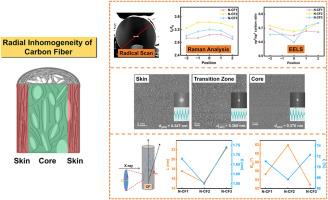揭示径向非均质性在确定pan基碳纤维抗拉强度中的作用:一种多尺度结构表征方法
IF 11.6
2区 材料科学
Q1 CHEMISTRY, PHYSICAL
引用次数: 0
摘要
提高高性能碳纤维的力学性能需要深入了解其多尺度结构-性能关系。本研究系统表征了三种具有不同拉伸强度的pan基碳纤维(N-CF1, N-CF2, N-CF3),以阐明径向结构非均质性对力学性能的影响。采用同步加速器广角x射线散射(WAXS)、微束WAXS (μ-WAXS)、球面像差校正透射电子显微镜(SA-TEM)、电子能量损失谱(EELS)、拉曼光谱、小角x射线散射(SAXS)和正电子湮灭寿命谱(PALS)等先进技术对sp2杂化碳的晶体尺寸、取向、皮核微晶演化、径向分布进行了评价。以及不同长度尺度上的微孔形态。结果表明,N-CF1具有均匀的皮核结构、高石墨化、致密排列的微晶和最小的缺陷密度,具有优异的抗拉强度。N-CF2晶体化程度较低,但sp2碳含量较高,保持了相对平衡的径向结构,尽管存在部分无序,但仍能有效传递应力。相反,N-CF3表现出局部高结晶度,但存在严重的径向非均质性和内部结构破坏,导致力学性能受损。这些发现强调了径向结构均匀性在决定碳纤维拉伸性能方面的关键作用,超过了平均结晶度的影响。本文章由计算机程序翻译,如有差异,请以英文原文为准。

Unveiling the role of radial heterogeneity in determining the tensile strength of PAN-based carbon fibers: A multiscale structural characterization approach
Advancing the mechanical performance of high-performance carbon fibers (CFs) necessitates a deep understanding of their multiscale structure-property relationships. This study systematically characterizes three PAN-based CFs (N-CF1, N-CF2, N-CF3) with varying tensile strengths to elucidate the impact of radial structural heterogeneity on mechanical properties. Advanced techniques including synchrotron-based wide-angle X-ray scattering (WAXS), microbeam WAXS (μ-WAXS), spherical aberration-corrected transmission electron microscopy (SA-TEM), electron energy loss spectroscopy (EELS), Raman spectroscopy, small-angle X-ray scattering (SAXS), and positron annihilation lifetime spectroscopy (PALS) have been employed to assess crystallite size, orientation, skin-core microcrystalline evolution, radial distribution of sp2 hybridized carbon, and micropore morphology across different length scales. Results demonstrate that N-CF1, with its homogeneous skin-core structure, high graphitization, dense and aligned microcrystallites, and minimal defect density, exhibits superior tensile strength. N-CF2, while less crystalline, maintains a relatively balanced radial structure with higher sp2 carbon content, facilitating effective stress transfer despite partial disorder. Conversely, N-CF3 displays localized high crystallinity but suffers from severe radial heterogeneity and disrupted internal structure, leading to compromised mechanical performance. These findings highlight the critical role of radial structural uniformity in determining the tensile properties of CFs, outweighing the influence of average crystallinity.
求助全文
通过发布文献求助,成功后即可免费获取论文全文。
去求助
来源期刊

Carbon
工程技术-材料科学:综合
CiteScore
20.80
自引率
7.30%
发文量
0
审稿时长
23 days
期刊介绍:
The journal Carbon is an international multidisciplinary forum for communicating scientific advances in the field of carbon materials. It reports new findings related to the formation, structure, properties, behaviors, and technological applications of carbons. Carbons are a broad class of ordered or disordered solid phases composed primarily of elemental carbon, including but not limited to carbon black, carbon fibers and filaments, carbon nanotubes, diamond and diamond-like carbon, fullerenes, glassy carbon, graphite, graphene, graphene-oxide, porous carbons, pyrolytic carbon, and other sp2 and non-sp2 hybridized carbon systems. Carbon is the companion title to the open access journal Carbon Trends. Relevant application areas for carbon materials include biology and medicine, catalysis, electronic, optoelectronic, spintronic, high-frequency, and photonic devices, energy storage and conversion systems, environmental applications and water treatment, smart materials and systems, and structural and thermal applications.
 求助内容:
求助内容: 应助结果提醒方式:
应助结果提醒方式:


